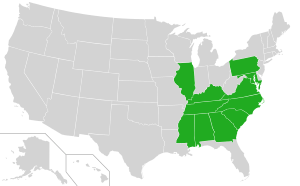Little sweet Betsy facts for kids
Quick facts for kids Little sweet Betsy |
|
|---|---|
 |
|
| Trillium cuneatum Cheekwood Botanical Garden Nashville, Tennessee |
|
| Conservation status | |
| Scientific classification | |
| Genus: |
Trillium
|
| Species: |
cuneatum
|
 |
|
| US distribution by state of Trillium cuneatum | |
| Synonyms | |
|
|
The little sweet Betsy (scientific name: Trillium cuneatum) is a cool flowering plant that grows in the southeastern United States. People also call it the whip-poor-will flower, large toadshade, purple toadshade, or bloody butcher.
This plant is very common in an area stretching from southern Kentucky through central Tennessee to northern Alabama. It is a perennial plant, which means it lives for more than two years. The little sweet Betsy blooms from early March to late April, depending on how far north or south it is. It is the biggest type of "sessile" trillium found in the eastern U.S.
Discovering the Little Sweet Betsy Plant
The little sweet Betsy likes to grow in rich soil in forests, especially where there is limestone. It can also be found in places with less limestone. You can find this plant growing at elevations from about 160 to 1,300 feet (50 to 400 meters) above sea level.
What Does It Look Like?
This plant has three wide, spotted leaves that surround its flower. The flower sits directly on top of the leaves, which is why it's called "sessile" (meaning it has no stem of its own). It has a unique smell, often described as smelling like bananas! The petals of the flower stand upright and can be maroon, bronze, green, or yellow.
Where Else Does It Grow?
You might find a few groups of little sweet Betsy plants in Michigan and other northern states. These plants likely got there because of human activities, like people moving them.
Recently, many people who enjoy citizen science have reported seeing this plant in the eastern United States. These sightings range from Washington, D.C. all the way to New York City. This shows how people are helping to track where plants grow!


